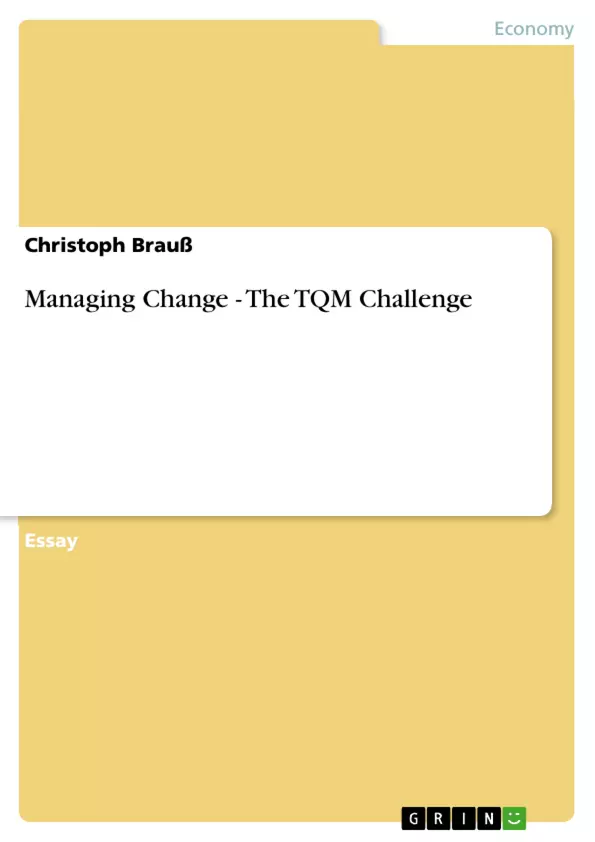In the today fast changing and global environment a successful implementations of modern and progressive strategies is the major success factor for a productive and competitive organisation. This organisational development is associated with the ability of change of the organisation itself. Furthermore it has to have the ability to adapt current market demands and apply them to the organisational behaviour and performance (McNish, 2001; Mullins, 2002; Rajagopalan, 1996).
This change process includes organisational culture, process chains, people and processes management (Gillies & Horward, 2003; Doppler & Lauterburg, 2000). But the main focus of attention is in the responsibility of the management and the executives of the company. A special change process can only be implemented by the managers and it has to evolve within the organisation (Mullins, 2002).
A change can be part of an organisational process – for example new machinery, equipment; regeneration of staff; market pressure; competitors; regular repair and maintenance, entrepreneurial growth and training and development of employees. The organisation itself has to be prepared to cross this change process regardingless if it is driven through external or internal forces (Pinnington & Edward, 2000; Burnes, 1997; Beer & Nohria, 2000).
So this organisational change process regardingles if it is a minor, major or transformational change calls for more attention of diagnosing, facilitating, planning and reinforcing then in the past. Especially in the manufacturing, automotive and consumer electronics industry the striving for better quality, lower costs and higher productivity demands a planned change process (Jun, 2004).
The following chapters outline an organisational change process in special manufacturing company. This major change is the sampling to lead the company to the theories of the Total Quality Management approach. It is surveyed with special consideration of the nature of change, change driving factors, the enforcement and resistance of this change. The paragraphs show a discussion about the implementation process of this organisational development with its challenges and chances of further development. This discussion is included in the organisational context.
Inhaltsverzeichnis (Table of Contents)
- UNDERSTANDING MANAGING CHANGE
- TQM IMPLEMENTATION
- The GmbH
- Drivers of Change
- Nature/Types of change
- Resistance and encouragement of change
- CONCLUSION / EVALUATING CHANGE
- LITERATURE
Zielsetzung und Themenschwerpunkte (Objectives and Key Themes)
This text examines the implementation of Total Quality Management (TQM) in a German manufacturing company, a band saw machine manufacturer. The main objective is to analyse the challenges and opportunities associated with this organizational change process, specifically focusing on the nature of change, driving factors, and resistance encountered. The text also discusses the potential benefits of TQM in terms of quality improvement, cost reduction, and enhanced productivity.
- The implementation of TQM as a strategy for organizational change
- Challenges and opportunities associated with TQM implementation
- The role of management in driving and supporting TQM adoption
- The importance of employee involvement and engagement in the change process
- The impact of TQM on organizational performance and competitiveness
Zusammenfassung der Kapitel (Chapter Summaries)
The first chapter provides a general overview of managing change in a dynamic global environment, highlighting the need for organizational adaptability and responsiveness to market demands. It emphasizes the importance of the management team in leading and driving change within the organization.
Chapter 3 focuses on the TQM implementation process within the specific manufacturing company. It details the company's structure, its product range, and its global market presence. The chapter outlines the initial stages of TQM adoption, including the gathering and analysis of data to identify areas for improvement. It also explores the use of various quality management approaches, such as Kaizen and "time and motion studies," to achieve continuous improvement.
The chapter further highlights the challenges faced by the company in implementing TQM, particularly regarding the resistance to change among employees and the difficulties in coordinating processes across different departments. It concludes with a discussion on the importance of employee involvement, resource management, and the role of management in driving a successful TQM implementation.
Schlüsselwörter (Keywords)
This text focuses on the topic of Total Quality Management (TQM) implementation as a strategy for organizational change. Key themes include organizational development, continuous improvement, employee engagement, resistance to change, and the impact of TQM on business performance and competitiveness. Further keywords include Kaizen, "time and motion studies" (REFA), quality management, process improvement, and global competition.
- Quote paper
- Dipl.-Ing. Christoph Brauß (Author), 2005, Managing Change - The TQM Challenge, Munich, GRIN Verlag, https://www.grin.com/document/63664



